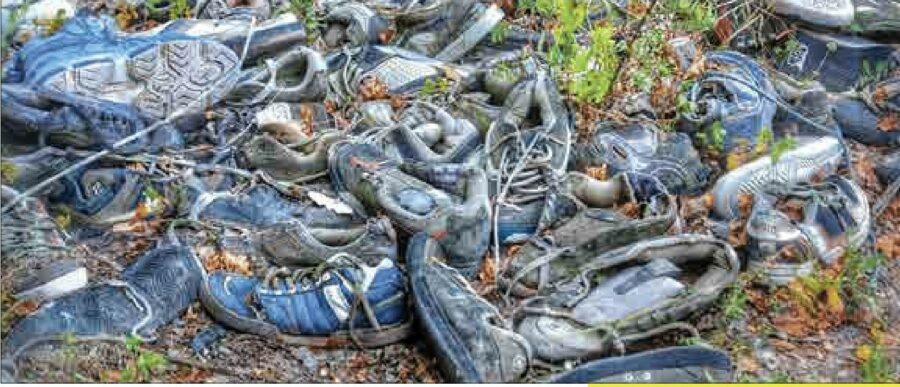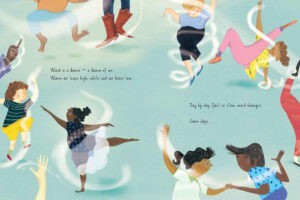GUEST BLOGGER JULIE DANNEBERG
Athletic shoes, or sneakers, are everywhere, worn by young and old, for sports, fashion, and just everyday comfort. In these lessons, students will look at the positive and negatives of one of today’s most popular clothing items.
Lesson objectives
Students will:
- Learn about the complex process of sneaker manufacturing and identify the different roles STEAM plays in that process.
- Learn about the scientific and engineering advances created to solve problems caused by the manufacturing and disposal of sneakers.
- Measure their own “footprint” in terms of the number of sneakers that they have contributed to landfills and then problem solve ways to decrease that footprint.
- Discuss/analyze the responsibility/problems of companies creating products that damage our environment.
Before reading
- To get students thinking about the prevalence of sneakers in their daily life, have them count the number of athletic shoes they currently own.
- Give students a quick overview of the history sneakers found on pages 77-82 of The Science of Fashion.
- Using the glossary, review the meaning of the following words: vulcanization, greenhouse gas, synthetic, carbon footprint, emission, nonrenewable resources, biodegradable, decompose, sustainable, prototype, assembly line.
- Ask students to guess how the manufacturing of sneakers might add to the world’s pollution problem. Prompt them with the following questions: What do you think sneakers are made of? Where are they made? What happens to sneakers after they wear out?
During reading
First day
- Read, or ask students to read, pages 82-84 in Chapter 5: How Sneakers are Made.
- Watch a video that shows the manufacturing process required to make shoes. As they watch, Identify/discuss how each manufacturing step reflects different aspects of STEAM. (7) Video | Facebook
- What possible problems are there from a pollution perspective?
Second day
- Read pages 84-88, Built on Innovation.
- What innovations improve the functionality and comfort of sneakers?
- How do innovations increase sales for sneaker companies? How many were really necessary?
- Activity: With a partner or small group, come up with your own innovations for improving a brand of sneakers you use.
Third day
- Read pgs. 88-90, Sustainable Sneakers.
- Ask students to reread the pages and list the ways pollution occurs during the life cycle of a pair of sneakers. Students may work with partners or in small groups.
- Come up with concrete actions to combat the problems.
After reading
- Discuss and share: What are your thoughts about the risks vs rewards of sneakers and the fact that they contribute so much to the world’s pollution? Does knowing that change your mind in terms of buying sneakers?
- Do companies have a responsibility to create products in this day and age that are sustainable and biodegradable? Why?
- What is your responsibility as a consumer?envior
- Have students create a list of doable actions they are willing to take to protect the environment.
Activity 1
Say to students: “As we read in the section on Sustainability, (pg. 92) sneakers can’t decompose because they are made of synthetic parts. However, they can break down into elemental parts. But it takes 30-40 years for that to happen! Consider that more than 23 billion (yes billion!) sneakers are made every year and more than 30 million pairs are thrown out every year. The following exercise will help you understand the magnitude of the problem present by the world’s sneaker obsession.”
- Take one pair of sneakers from your closet. Fit them tightly together and then measure the length and width and depth of the space they take up. Use your calculations to find the area your sneakers would take up in a landfill.
- Multiply that area by how many sneakers you own. That is the amount of space that your current shoes will take up in your local landfills for the next 30 to 40 years.
- How much landfill space will the sneakers of your family be taking up? Your classroom? Your school?
Activity 2
Students should now understand the environmental problems caused by manufacturing and getting rid of sneakers. Next, investigate other shoes made partly or completely with rubber.
More on fast fashion
Julie Danneberg has taught both elementary special education teacher and middle school language arts. Spurred on by her teaching, she began writing for children. She has written multiple picture books, both fiction and nonfiction, including the bestselling Jitters series, starting with First Day Jitters (Charlesbridge, 2000), and continuing on to the more recent Picture Day Jitters (Charlesbridge, 2022). Upon retirement several years ago, she wrote two STEAM books for the Nomad Press Inquire and Investigate series: The Science of Weather and Climate: Rain, Sleet, and the Rising Tide (2020) and The Science of Fashion (2021). She is married, has two adult children and lives in Boulder, Colorado where she loves to hike and bike, read, and write.
See more about her books at www.juliedanneberg.com
Visit this blog post for links to videos used to teach students the three stages of the reading process for expository text. Teaching the Reading Process (with videos) – Julie Danneberg
For classroom guides and free printable visit Nomad Press here: The Science of Fashion – Nomad Press
Twitter handle @DannebergJulie
SCIENCE OF FASHION is part of the Nomad Press Inquire and Investigate series and has STEAM activities throughout the text as well as links to primary sources. Written for grades 7-10, both the content and activities are adaptable to elementary school classrooms.











Leave a Reply
Your email is safe with me.